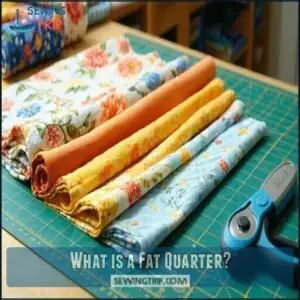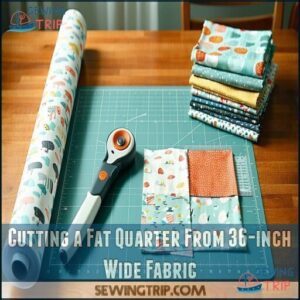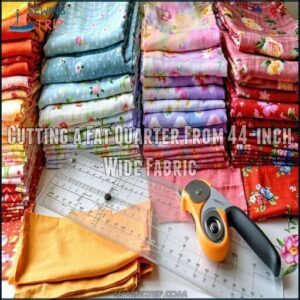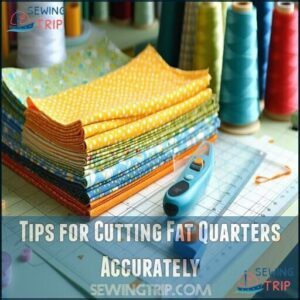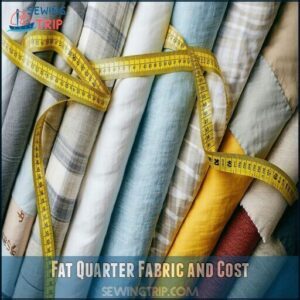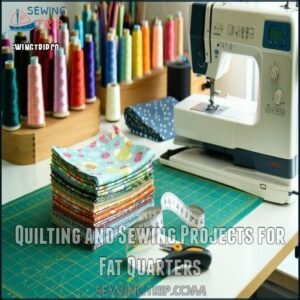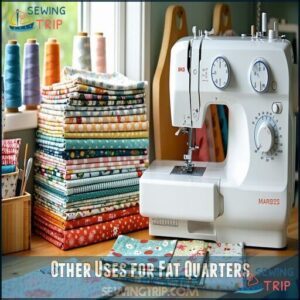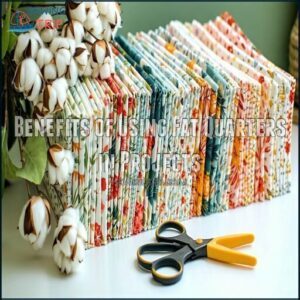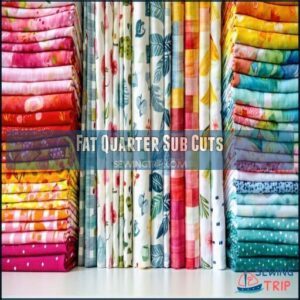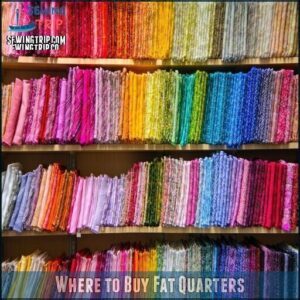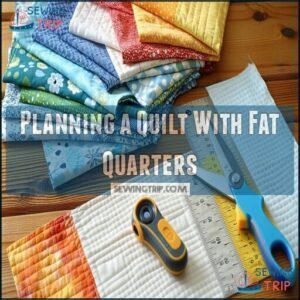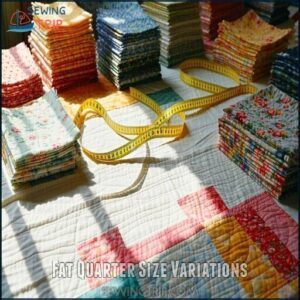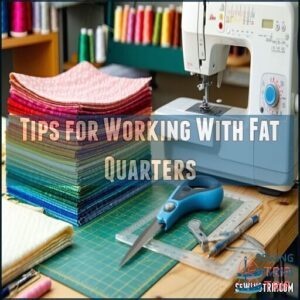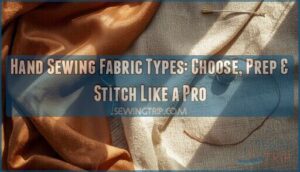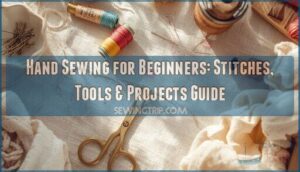This site is supported by our readers. We may earn a commission, at no cost to you, if you purchase through links.
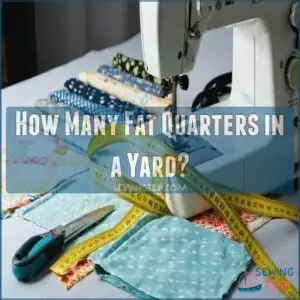
Well, you’ll get 4 fat quarters from a yard of fabric. That’s a convenient fact to know when figuring out how much material you’ll have to work with.
Now that you know the answer to "how many fat quarters in a yard", you’re probably curious about the best ways to use them in your projects – and we can provide some valuable tips and insights coming right up.
Table Of Contents
- Key Takeaways
- What is a Fat Quarter?
- How Many Fat Quarters in a Yard?
- How to Cut a Fat Quarter
- Fat Quarter Fabric and Cost
- What Can You Use Fat Quarters For?
- Fat Quarter Sub Cuts
- Where to Buy Fat Quarters
- Planning a Quilt With Fat Quarters
- Fat Quarter Size Variations
- Tips for Working With Fat Quarters
- Frequently Asked Questions (FAQs)
- Conclusion
Key Takeaways
- You’ll get 4 fat quarters from a yard of fabric, each measuring about 18" x 22", which is perfect for various sewing projects and quilting endeavors.
- A fat quarter isn’t the same as a quarter yard, as their sizes differ due to fabric width and cutting methods, so you’ll need to consider this when planning your projects.
- You can cut a yard of fabric into 4 fat quarters by cutting it into two half-yards and then halving each, which gives you a convenient way to work with smaller pieces of fabric.
- Buying fat quarters can be cheaper for small projects or when you want a variety of patterns and colors, but it’s often more cost-effective to buy fabric by the yard for larger projects.
What is a Fat Quarter?
You’re probably wondering what a fat quarter is and how it differs from a regular quarter yard of fabric.
Discover the world of fat quarters, a sewer’s best friend for flexibility and creativity
A fat quarter is a cut of fabric that measures 18" x 22", which is a more practical size for many sewing projects, and you’ll learn more about its uses and dimensions in this section.
Fat Quarter Size and Dimensions
How do fat quarter dimensions impact your projects?
A fat quarter’s standard dimensions are 18×22 inches, offering more flexibility than a regular quarter yard.
- They match common sizes for small projects
- Accommodate embroidery hoops or appliqué work
- Reduce fabric folds, saving time
- Offer cutting accuracy with less leftover material
- Adapt to width variations in fabric
With a fat quarter, you get a larger surface area, perfect for creative freedom and less waste.
Many quilters find that using pre-cut fabric bundles simplifies fabric selection.
Understanding fat quarter size and dimensions is essential for accurate fabric yard conversion and area calculation, ensuring size accuracy in your projects.
Fat Quarter Vs. Regular Quarter Yard
When working with fabric, you’ll find a regular quarter yard measures 9×44 inches, ideal for long strips.
While a fat quarter offers an 18×22-inch rectangle, perfect for quilting basics and cuts, providing better design flexibility and cutting efficiency in your projects.
Uses and Dimensions of Fat Quarters
You’ll love using fat quarters, with their 18" x 22" dimensions, for various projects, as they reduce fabric waste and offer flexibility.
They are perfect for sewing, quilting, and mask making, with accurate fabric measurements simplifying planning and allowing for bundle variety.
How Many Fat Quarters in a Yard?
You’re probably wondering how many fat quarters you can get from a yard of fabric, and the answer is simple: one yard typically yields four fat quarters.
To calculate this, you’ll need to understand how fat quarters are cut from a yard, which is usually done by dividing the yard into two half-yard pieces and then cutting each in half again to get the desired fat quarters.
Calculating Fat Quarters From a Yard
When you buy a yard of fabric, you can yield four fat quarters. To calculate this, cut your yard in half lengthwise, then cut each half widthwise. This gives you four panels, each measuring 18” x 22”. Accurate folding is key to maximizing fabric potential.
- Save money by stretching your yard
- Reduce scraps and use every bit
- Experiment with different colors and prints
- Feel like a pro mastering yard-to-fat-quarter calculations
- Simplify sewing estimates with ease
By understanding yard to quarter conversions, you can make bulk cutting and selling quarters more efficient, improving your fabric calculations and measurements, which helps in maximizing fabric potential and allows you to save money.
Cutting Fat Quarters From a Yard
Now that you know how many fat quarters are in a yard, let’s get cutting.
To cut fat quarters from a yard of fabric, follow these steps:
- Press your fabric to avoid creases
- Lay it flat for accurate measurements
- Use a rotary cutter and quilting ruler
- Measure twice, cut once
- Keep leftover scraps for accents
Cutting fat quarters is simple: divide the yard in half, fold, and cut along the fold.
This technique helps minimize waste and guarantees efficient layout, considering the fabric grain for a smooth yard to quarter conversion using proper fabric cutting tools and techniques.
How to Cut a Fat Quarter
You’ll learn how to cut a fat quarter from a yard of fabric, which is an essential skill for any sewing or quilting project.
By following a few simple steps, you can cut accurate fat quarters, whether you’re working with 36-inch or 44-inch wide fabric, and make the most of your material.
Cutting a Fat Quarter From 36-inch Wide Fabric
You’re now cutting a fat quarter from 36-inch wide fabric.
Fold the yard lengthwise to 18 inches, then cut across the width to create two half-yard pieces. Fold each in half and cut through the center, yielding four 18 x 18 inch fat quarters.
This method minimizes fabric loss, making it suitable for projects requiring smaller pieces.
You can find a variety of 36 inch fabrics online.
Alternative methods can affect yield optimization and cost implications, so consider your fabric cutting needs carefully to get the most out of your fabric.
Cutting a Fat Quarter From 44-inch Wide Fabric
To cut a fat quarter from 44-inch fabric, follow these steps:
- Fold accurately
- Measure 18 inches
- Cut
- Repeat
- Check seam allowance, considering fabric grain for accurate folding and minimal leftover fabric.
Many crafters buy pre-cut fat quarters for convenience.
The process involves careful consideration of fabric grain to ensure accurate folding and minimal leftover fabric.
Tips for Cutting Fat Quarters Accurately
To achieve accurate folding, start by smoothing out creases.
Use measuring techniques and check your fabric width to guarantee consistent sizes. Invest in quality cutting tools for precise cuts.
Mastering fabric cutting techniques and measurement will help you get the perfect fat quarter size every time, making your fabric cutting tutorial a success with accurate fabric accuracy.
Fat Quarter Fabric and Cost
You’re probably wondering how much fat quarters cost and what types of fabric they come in.
When you buy fat quarters, you’ll find they’re available in various fabrics, and their cost can vary depending on the type and quality of the fabric.
This is something to keep in mind and consider your needs.
Types of Fabric Used for Fat Quarters
When selecting fabrics for your project, consider the types of fat quarters available.
You can choose from:
- Cotton Varieties for softness
- Linen Options for texture
- Synthetic Blends for durability
- Silk Choices for elegance
- Wool Types for coziness.
These options offer varying fabric sizes, dimensions, and fat quarter sizes, making it easy to find the perfect match for your needs, with a fabric cutting guide to help you navigate fabric width and dimensions.
Selecting the right material also depends on desired fabric properties, such as breathability and drape, which can be found at desired fabric properties.
Cost Comparison: Fat Quarters Vs. Yardage
When buying fabric, you weigh fat quarters and yardage.
Fat quarters offer flexibility, while yardage is cost-effective for large projects.
Consider your project fabric needs and budget.
- Fat quarters prevent overspending on extras
- Yardage is perfect for bigger projects
- Fat quarters encourage quilt creativity
- Bulk fabric pricing affects your budget
You can buy fat quarters in bulk, but yardage often gives better value.
Balance your fabric cost with project requirements, and don’t forget to account for scrap fabric usage.
The precut advantage of fat quarters comes at a cost, so budget wisely for your quilting fabric needs, whether you choose fat quarters or yardage.
Factors Affecting The Cost of Fat Quarters
When considering fat quarters, you’ll find that fabric prices depend on the fabric type, printing costs, and retailer markup.
Limited editions and bundle size can also impact the cost.
To get the best deal, watch for fabric sales and compare prices.
Remember, fat quarters can vary in price, so balancing quality and cost is key to staying within your budget and finding the perfect fabric for your project.
What Can You Use Fat Quarters For?
You can use fat quarters for a variety of projects, including quilting, sewing, and crafting.
They’re perfect for making small items like face masks, pouches, and patchwork, and you can also use them for larger projects like quilts and home decor items.
Quilting and Sewing Projects for Fat Quarters
You’re now exploring quilting and sewing projects for fat quarters. Fat quarters bring versatility to your creations.
Here are 3 ways to use them:
- Quilt size variations
- Mask making and appliqué projects
- Patchwork ideas with bundle variety.
With fat quarters, you can create unique quilting projects using quilting fabric, considering fat quarter size for the perfect fit, and enjoying the freedom to mix and match fabric for exciting results in your quilting fabric endeavors.
Other Uses for Fat Quarters
You can use fat quarters for various projects beyond quilting, like mask making, appliqué projects, and patchwork ideas.
They’re perfect for small pouches and other accessories. With bundle variety, you can mix and match fabrics for unique creations.
Fat quarters are a great way to add some personality to your sewing projects, and they’re often made from high-quality quilting fabric.
Try using them for home decor items, like throw pillows or table runners, to add a touch of handmade charm. Fat quarter projects are endless, and they’re a great way to get creative with fabric.
Benefits of Using Fat Quarters in Projects
You’ll love fat quarters for their Pattern Flexibility and Cost Savings.
They offer:
- Efficient Cutting
- Project Variety
- Stash Building
Fat quarters are perfect for quilting projects, allowing you to create with precut fabric and fabric bundles, making fat quarter projects a breeze.
Fat Quarter Sub Cuts
You’re looking to explore the realm of fat quarter sub cuts, which are smaller pieces cut from a fat quarter.
By cutting a fat quarter in half, you can create a fat eighth, or use charm packs, mini charm packs, jelly rolls, and layer cakes to add variety to your sewing projects.
Fat Eighth: a Fat Quarter Cut in Half
You’ll find that cutting fat quarters in half creates fat eighths, perfect for intricate projects.
These 9" x 22" pieces are great for applique or adding small details.
They help reduce fabric waste and are suitable for various projects, allowing you to make the most of your fabric sizes and dimensions, which is ideal for intricate projects.
Charm Packs and Mini Charm Packs
You’ll enjoy working with charm packs and mini charms, offering precut fabric squares.
- Simplify projects
- Increase variety
- Save time
- Enhance creativity
- Reduce waste
They’re perfect for patchwork, providing coordinating packs and precise measurements, similar to fat quarters, but with more flexibility in charm pack sizes and mini charm projects.
Jelly Rolls and Layer Cakes
You’re working with fat quarters, now let’s explore jelly rolls and layer cakes.
- Simplify projects with precut strips
- Use layer cakes for uniform blocks
- Store bundles neatly to avoid unraveling, making fabric calculations easier with jelly rolls and layer cakes, not just fat quarters or a yard.
Where to Buy Fat Quarters
You can find fat quarters at various online retailers, fabric shops, and discount stores, making it easy to get the ones you need.
When you’re looking to buy fat quarters, you’ll have options to purchase them individually or in bulk, depending on your project’s requirements.
Online Retailers and Fabric Shops
You’re looking for the perfect fat quarters for your next project.
Online fabric stores offer a wide online selection, making it easy to find what you need. Check out fabric stores like Michaels, JoAnn, and Hobby Lobby for a variety of fat quarters.
When shopping online, consider pricing strategies, shipping costs, and return policies. Many retailers offer fat quarters online for convenient shopping.
Read customer reviews to confirm you’re getting quality fabric. Whether you prefer to shop at an online store or a local store, you’ll find plenty of options for fat quarters to inspire your creativity and bring your project to life with the right fabric.
Discount Stores and Sales
After exploring online options, let’s check out some deals.
Getting discount fat quarters can be super satisfying. Here’s how you can save:
- Clearance Events: Check stores such as Walmart, Michaels, JoAnn fabrics, and Hobby Lobby. You’ll find Walmart fat quarters and Michaels sales make fabric affordable.
- Coupon Codes: Don’t skip flyers. JoAnn’s and Michaels often have great savings.
- Price Matching: Ask stores to match competitors’ discounts, especially during a fabric sale.
Saving on stylish fat quarters has never been easier!
Rotary cutters guarantee precise cuts.
Next, we’ll explore bulk discounts.
Buying Fat Quarters in Bulk
You’re ready to stock up on fat quarters. Buying in bulk can be a great way to save money.
Many shops offer wholesale options or bundle deals. Consider subscribing to fabric newsletters for exclusive discounts.
- Find bulk discounts
- Organize your fabric
- Plan projects ahead
This approach helps you get the most out of your fabric budget, with a variety of precut fat quarters to choose from, making project planning easier, and utilizing storage solutions to keep your fabric size options tidy.
Planning a Quilt With Fat Quarters
You’re planning a quilt and wondering how to work with fat quarters.
When you’re choosing fat quarters for your quilt, you’ll need to calculate how many you’ll need, considering the size of your quilt and the patterns you want to use.
Choose fat quarters wisely for a stunning quilt finish
Choosing Fat Quarters for a Quilt
You’re selecting fat quarters for your quilt, considering Pattern Coordination, Color Palettes, and Fabric Weight.
| Quilt Design | Fabric for Quilting |
|---|---|
| Small | 2-3 fat quarters |
| Medium | 4-6 fat quarters |
| Large | 8-10 fat quarters |
| Extra Large | 12+ fat quarters |
| Custom | varies by Project Size |
Choose fat quarters that fit your quilting projects, ensuring a beautiful quilt design with the right fabric.
Calculating Fabric Requirements for a Quilt
You’re now calculating fabric requirements for your quilt.
To do this, consider your quilt size and block dimensions.
Here are steps to follow:
- Measure quilt size
- Determine blocks needed
- Calculate fabric per block
- Multiply by blocks
- Add 10% extra.
This helps minimize fabric waste and guarantees you have enough for border fabrics and backing needs, using fat quarters efficiently from a yard of fabric for quilting.
Tips for Working With Fat Quarters in Quilts
You’re now working with fat quarters in quilting projects.
To make the process smooth, consider these 5 tips:
- Test fabric selection
- Pre-wash fabrics
- Roll fat quarters
- Label cuts
- Group similar tones.
This helps with pattern matching and cutting efficiency, ensuring a beautiful quilt with the right seam allowance.
With dimensions of 18 x 21, fat quarters offer flexibility in cutting.
Effective layout planning is key to a successful project, making the most of your fat quarters and fabric cutting tips for stunning quilting projects.
Fat Quarter Size Variations
You’ll find that fat quarter sizes can vary depending on the fabric’s width, which is usually between 42 and 44 inches.
When you’re working with fat quarters, to maximize your fabric, you must understand these size variations to get the most out of your fabric.
Standard American Fat Quarter Size
You’ll find a standard American fat quarter measures 18" x 22", perfect for quilting.
- Pre-cut sizes save time
- Mix and match designs
- Use for small projects
- Get versatile pieces from a yard
Easy to handle, they’re a favorite among quilters, offering standard dimensions and inch conversion to metric equivalent, making fabric size and dimensions simple to understand from a fabric bolt or yard, which is why fat quarter is a popular choice.
Canadian Fat Quarter Size
You’ll discover Canadian fat quarters are larger, measuring 49 x 55 cm, offering greater cutting flexibility for quilting projects.
With metric conversions and regional availability affecting fabric standards and retailer differences in fabric dimensions and size, quilting preferences are impacted for fat quarters and fabric measurement, considering fat quarters as a key factor.
International Fat Quarter Sizes
You’ll encounter various fat quarter sizes globally.
- European Sizes: 50cm x 55cm
- Asian Sizes: larger cuts
- Metric Conversion: affects fabric dimensions
- Size Discrepancies: occur due to regional availability
Fabric measurement differs from a standard yard, with fat quarters offering unique possibilities for projects, considering metric conversion and regional fabric measurement variations.
Tips for Working With Fat Quarters
You’re now ready to work with fat quarters, and it’s time to learn some tips to make the most of them.
By following these tips, you’ll be able to store, cut, and sew with fat quarters like a pro.
You’ll also be able to troubleshoot any common issues that come up.
Storing and Organizing Fat Quarters
You can tame your fat quarter collection with smart storage methods.
Use fat quarter bins or fabric folding "files" on quilt racks to optimize space and showcase your stash.
Clear storage boxes and sewing stations keep fabric organized, making inventory management a breeze.
Implement project-based storage and color coordination to maximize your fabric organization and make the most of your fat quarters, ensuring a serene and efficient sewing space.
Cutting and Sewing With Fat Quarters
You’re now cutting and sewing with fat quarters.
For efficient cutting, use a sharp rotary cutter and mat. Here are tips:
- Prep fabric by ironing out wrinkles.
- Cut with control using long strokes.
- Stack fat quarters for speedy identical strips.
Mastering these sewing techniques reduces fabric waste, making your project ideas shine with perfect pattern matching, especially with quilting fabric cuts from a yard of fabric.
Troubleshooting Common Issues With Fat Quarters
When working with fat quarters, you’ll encounter uneven sizes, fraying edges, and color bleeding.
Prewash shrinkage can also occur.
To avoid cutting errors, double-check measurements, especially when cutting from a yard of fabric.
Verify that your fat quarters match the standard 18” x 22” size for smooth sewing and stress-free crafting, preventing issues like uneven selvages and wonky measurements.
Frequently Asked Questions (FAQs)
How many Fat quarters in a yard of fabric?
You’ll get four fat quarters from a yard of fabric, each measuring about 18" x 22", perfect for various sewing projects and quilting endeavors with ease and flexibility always.
How many Fat quarters can you cut from a yard?
Can you envision a yard of fabric? You can cut four fat quarters from it, each approximately 18" x 22", perfect for various sewing projects and crafts, offering flexibility and convenience.
What size is a fat quarter?
You’ll find a fat quarter typically measures 18 inches by 22 inches, perfect for various sewing projects, offering flexibility and efficiency in fabric usage.
Is a quarter yard the same as a fat quarter?
You’ll discover a quarter yard isn’t the same as a fat quarter, as their sizes differ due to fabric width and cutting methods, affecting project outcomes.
How do you get 4 Fat quarters from a yard?
Imagine unfolding a yard of fabric, you’ll cut it into two half-yards, then halve each, yielding four fat quarters, each approximately 18" x 22".
What is the proportion of a fat quarter?
You’ll get a fat quarter, which is 1/4 of a yard of fabric, typically measuring 18" x 22", perfect for small projects and mixing patterns efficiently in your sewing endeavors.
Is it cheaper to buy fat quarters?
You’ll often save money buying fabric by the yard, but fat quarters can be cheaper for small projects or when you want a variety of patterns and colors.
How many fat quarters can you get from a yard?
You can typically get four fat quarters from a yard of fabric, depending on the fabric’s width, which is a great way to have variety for your sewing projects.
Is a 1/4 yard the same as a fat quarter?
You’ll find a fat quarter isn’t exactly the same as a 1/4 yard, due to differences in fabric width and cutting methods, affecting overall size and usability.
What is a ‘fat quarter’ in a quilt?
Imagine diving into a quilt project, you’ll discover a ‘fat quarter’ is a piece of fabric, about 18" x 22", perfect for small projects and mixing patterns.
Conclusion
You’re now a pro at figuring out how many fat quarters in a yard, and you can confidently plan your sewing projects.
Knowing you get 4 fat quarters from a yard helps.
You’ll save time and fabric by using fat quarters efficiently, so go ahead and get creative with your fat quarters in a yard.

